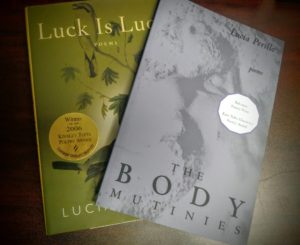Acknowledging Lucia Perillo’s Passing

The end of each year is often a time of rumination and remembrance, a reflective season of paying tribute to those we have lost during the past twelve months. As 2016 draws to a close we find it necessary to honor former Claremont Graduate University Kingsley & Kate Tufts Poetry Award winner Lucia Perillo, who passed away this October.
Perillo is the only poet CGU has awarded thus far – a span of 25 years—with both the Kate and Kingsley Tufts prizes. Her 1996 collection The Body Mutinies garnered the Kate Tufts Discovery Award for newly emerging poetic voices in 1997. And, almost ten years later, her book of poems Luck is Luck (2005) earned her the Kingsley Tufts Award for midcareer poets in 2006.
Throughout each of these collections, Perillo exhibits a lyrical power and versatility. Her intricate tone is often one of raw and tender sensuality, pregnant with a questioning form of longing. Seemingly one of her favorite and most effective techniques is placing two disparate objects or actions into a state of intriguing comparative tension. Through her poetic lens, rebellious Catholic girls become cheetahs stalking the savanna, the rush of sperm to reach the egg mirrors the poet’s own racing repetitions in a lap pool, 4th of July fireworks are presented as indistinguishable from the exploding shells of warfare, and the egg’s monthly slip from the slick side of the ovary parallels the mortal fall of amateur rock climbers. In each text, the poet additionally demonstrates a wide range of poetic inspirations. She writes of childhood, dream imagery, and laundromat realizations, penning verses about Dolly the cloned sheep, Frida Kahlo, and Marilyn Monroe. Perillo composes odes to her own nose, muses on the suicide rate of dentists, and contemplates cast iron tubs; she is equally inspired by Hawaiian lava artists and marsh birds, ancient proverbs and sunken ships, female serial killers and a shop fire in 1930s Tokyo.
But perhaps Lucia Perillo’s most compelling poetic preoccupation, in light of her battle against multiple sclerosis beginning at the age of 30 and ending with her recent death at age 58, was her recurring exploration of life’s cruel irony – that the flagging corporeal body was built to eventually betray the unwavering human spirit. In The Body Mutinies, a younger Perillo contemplates her accumulating mortality. In “Women Who Sleep On Stones,” the poet rhetorically inquires, “doesn’t the body foil what it loves best?” “Thinking About Illness After Reading About Tennesse Fainting Goats” finds the poet considering “what the body’s darker fortunes mean – / we break, we rise. We do what we’re here for.” And in “Cairn for Future Travel,” Perillo observes “I was young for a minute, but then I got old. Already the black cane stands by / the threshold…So not long now / Before I will have what follows” and then asks her readers, “And you, are you ready?” Within this collection, the poet readies herself for approaching death by undauntedly observing the crumbling act of aging.
Almost a decade later, in Luck is Luck Perillo continues to contemplate the limitations of aging flesh juxtaposed against the undimmed fire it contains but increasingly fails to sustain. In “At the Dowdle Funeral Home” the poet scrutinizes a corpse with an unflinching curiosity: “I wanted to feel / this monster business of the body.” “Outtake In Which No Words Are Said” addresses the beginning hopes and eventual realities of physical existence, viewing flesh bound life from a cyclical perspective: “What spring expected, fall defeated.” And in “Fizz Ed” Perillo speaks to the alarming and harsh actuality of old age:
Hard to pinpoint when the body starts turning.
One minute we’re Burt Lancaster and Deborah Kerr
heavy-petting in the surf, but then the surf pulls out
sizzling like grease and suddenly we find
ourselves no longer shrouded by the Pacific Ocean’s glamorous foam.
Instead, think elephant seals: all snout and lobe and whisker.
All gluey effluence and ectomorphic musk.
Here the aging process is figured in terms of vulnerable hideousness, a forceful act of tearing away the illusions of remaining youthful beauty.
Following on the heels of Luck is Luck, Perillo continued to investigate this theme of bodily decay in additional poetry collections including 2009’s Inseminating the Elephant and 2012’s On the Spectrum of Possible Deaths. As the name suggests, her final work, Time Will Clean the Carcass Bones (2016), is both a retrospective and a look forward into the diminishing future that gives a nod to the inescapable destruction and eventual cleansing inherent in the passage of time.
But hints of this acceptance of the inevitability of illness and death, and Perillo’s ability to creatively refashion her grim observations into more hopeful yet still honest poetic phrases, can also be found in her earlier poetry. In The Body Mutinies’ “The Body Rising” the poet advocates a detachment from the physical fear of death: “the body…that understands / its elements so well it can revert to them in a blink. / And maybe we serve the body most faithfully when we abandon it.” And in “Salmon Song” from Luck is Luck, Perillo notes that the body’s ruination is just another form of transformation: “rot or scar, scar or rot – / either way we’ll be made into something new.”
Ironically, by crafting a body of poetic work that centers on the ensuing destruction of her body, by focusing on her own mortality with such poetic skill, Lucia Perillo has achieved a form of immortality. Despite the failing of her physical body, through her printed words her spirit and voice remains undimmed. Though we have lost this Kingsley & Kate Tufts poet, her poetry lives on, securely safeguarded on the page.
—Brock Rustin
Share
